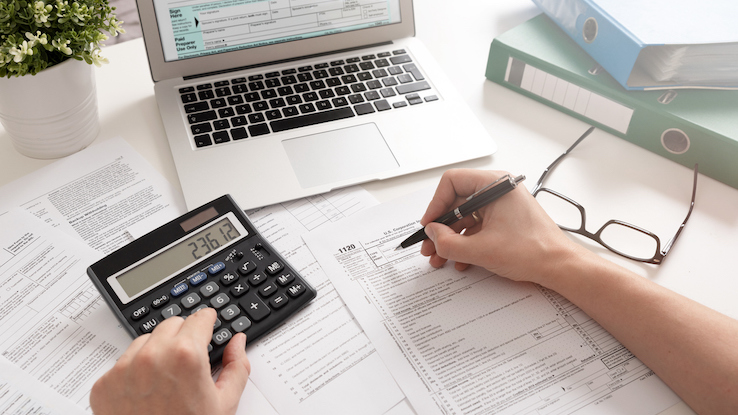
Whether you own a brick-and-mortar business or you earn most of your income by freelancing from home, the way you earn money could create a unique tax situation for you. If you make all or a portion of your income through self-employment, you’ll likely need to pay income taxes more often than once every April. Instead of making annual payments, you’ll owe quarterly taxes several times throughout the year and not just on the fifteenth of September.
Quarterly taxes are based on estimates of how much you’ll owe in taxes for a calendar year. They can be helpful if you don’t work for an employer that automatically withholds taxes from your paychecks or if you earn income in non-traditional ways, such as from interest on investments. But, as with all taxes, there are some key details to understand to ensure you’re estimating and paying quarterly taxes correctly. Get to know the basics with this helpful guide.
What Are Quarterly Taxes?

Quarterly taxes are payments you make four times a year. They’re meant for people who don’t have taxes withheld from their paychecks. Employees who receive W-2s at the end of the year have had Social Security, income, and other taxes automatically withheld from their checks, which streamlines the process of paying taxes to the government. If you’re not an employee at a company but you earn income, you’ll receive Form 1099 from any businesses that paid you money for services you provided throughout the year. If you’re self-employed, you’re responsible for figuring out and paying your own taxes based on the details on your 1099 forms. No money was withheld from your checks to cover tax payments.
Many people think of taxes as a once-a-year obligation that happens at tax time, but that’s sort of a misconception. In fact, most taxpayers pay taxes every time they receive a paycheck. Filing taxes during tax season is more of a reconciliation process. The IRS pays you back if you’ve paid too much throughout the year, and you pay the IRS if you didn’t have enough money withheld from your checks throughout the year.
Even if you don’t have money withheld from checks you earn because you’re self-employed, the federal government still wants you to pay taxes as you receive income — the same way people who are traditionally employed do. The process simply looks a bit different. Instead of paying a portion of money from each paycheck, you’ll pay taxes each quarter.
Quarterly taxes divide the year into four three-month periods. The periods run from January to March, from April to May, from June to August, and from September to December. Each quarterly tax deadline falls on the 15th day of the first month following the end of the quarter. On these dates, you’ll owe payments based on your income from the previous year.
Who Owes Quarterly Taxes?

In general, you need to pay quarterly taxes if you earn income that’s not automatically taxed throughout the year. For the sake of taxes, income includes more than the money you make from working. Income includes almost any source of money that flows into your household, such as alimony, prize winnings, or capital gains.
If you’re self-employed, your earnings likely aren’t taxed throughout the year unless you formally pay yourself through a payroll system that withholds taxes from your earnings. You owe quarterly taxes as long as you expect to owe at least $1,000 at tax time. If you do a little bit of reselling on the side and only made $500 last year, you’re not likely to need to pay quarterly taxes. If you’re a plumber who earns $100,000 per year in your sole proprietorship (and you pay yourself without withholding income taxes), you definitely need to pay quarterly taxes.
Some people ask, “Why can’t I just wait until the end of the year to pay taxes?” There are penalties for paying taxes late. If you owe quarterly taxes, waiting until the end of the year to pay your taxes could result in paying penalties on four missed tax payments.
If you’re self-employed and work at a non-self-employed job, you may be able to avoid paying quarterly taxes by adjusting your withholding. Each year, you fill out a W-4 form for any form of employment that withholds taxes from your income. On the form, there’s a box for additional withholdings. The number you put in the box represents what will be withheld from each paycheck in addition to any taxes you’d otherwise owe. The IRS has a Tax Withholding Estimator tool to help you calculate how much you should withhold from each check.
How to Pay Quarterly Taxes

To pay quarterly taxes, complete Form 1040-ES by each quarterly tax filing deadline. This tax form has a worksheet that walks you through estimating how much in taxes you owe for the quarter. For the first year that you owe quarterly taxes, you base your estimation of how much you’ll earn on what you believe you’ll earn. After the first year, you base your estimates on your earnings from the previous year.
You pay the estimated amount of your tax obligation each quarter. You can pay through the mail by sending a check along with a tax voucher to the IRS. Form 1040-ES includes enough vouchers for the year, along with mailing instructions. Many taxpayers also opt to pay online using the IRS’s EFTPS system. To use the system, you need to create a profile. Part of the account creation process involves receiving a mailed code from the IRS, so be sure to set up your account well before the deadline to pay.
At the end of the year, you file a tax return with your final figures. You’ll receive a tax refund if you overestimated the taxes you owe. And you’ll owe money to the IRS if you underestimated your taxes.
Although quarterly taxes are estimates, they’re not optional. If you can’t afford to pay your quarterly taxes, you still need to file Form 1040-ES. Then, work with the IRS on making a payment plan. If you think you’ll be able to pay quickly, you can request an extension on your filing deadline. The IRS also offers payment plans for people who are unable to pay their taxes in one lump sum.
It’s important to understand the quarterly deadlines and learn to use the worksheet on Form 1040-ES to calculate how much you owe accurately. When your estimates are as accurate as possible, your likelihood of owing a significant amount when you file your annual tax return decreases. If your earning situation is complicated, it’s wise to hire a tax professional to help you with your quarterly taxes.






